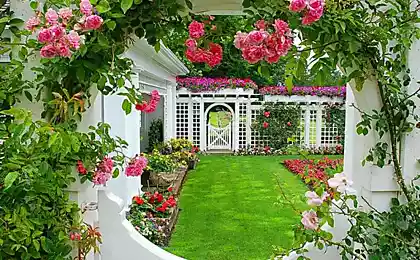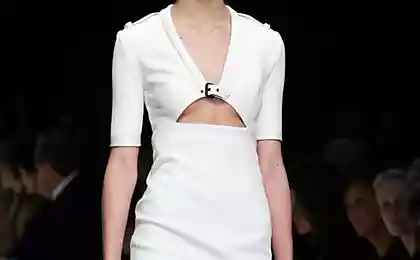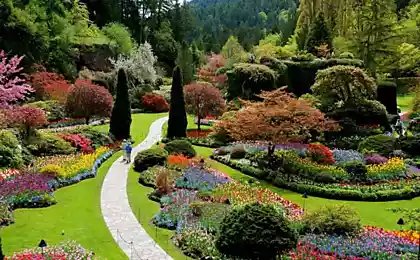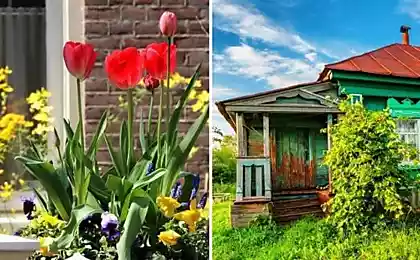419
How to add color to the winter garden
Summer pleases with lush flowering and colorful colors, but it passes. Pass and golden-purple autumn, and off-season with its Gothic gray-fog halftones. Winter is coming into its own.
One fine morning you look out the window and see that the garden is covered with white carpet. It was as if he had lost his colors and fell asleep waiting for spring. How to break the stereotype that the garden in winter is a snow cover with dull peeping naked trees? How to make it a variety and bright accents?

Where to start?
The most “timely” answer to the question “Where to start?” will be the famous saying about the sled in summer and the cart in winter. In the role of a sled, we have the preparation of a plot plan and marking up on it all the “winter” details that need to be taken into account. For example, where it is better to plant evergreen plants and which ones. But more on that later.
In the meantime, we arm ourselves with paper, pencil, irrepressible imagination of the gardener and the necessary knowledge and sketch a plan. It is best to do this in early spring, in March-April. At this time, the garden is quite naked, and you can see in detail how it looks as a whole. In the eyes immediately throw areas with uneven landscape.
You will see where there are too many shrubs or trees, and where, on the contrary, empty. Will not go unnoticed and "mistakes of economic purpose": compost box, old barrels, covering material or forgotten from the autumn inventory. In summer, during the period of active flowering, such nuances are not visible. And here it is immediately clear what is most naked in winter and how best to hide it.

If everything is cleaned up or does not confuse you and fits perfectly into the overall picture, you can just experiment and bring brightness to the winter landscape. It's done in different ways. The first thing that comes to mind is the decoration of the garden with the help of trees, shrubs and other plants. Let's call it plant-based.
Plant decoration for the winter garden
This option is ideal for lovers of naturalness, since there is no excessive gaggyness and heaping of elements alien to nature. To preserve the “vegetable” brightness and originality of the garden in winter, it is enough to choose in advance and plant the right specimens.

It is difficult to immediately navigate the variety of plants suitable for our venture. It is better to divide them into groups, each of which is responsible for a certain “highlight”. It's important not to overdo it. Still, in the winter garden there should be enough space for cold winds, swinging tree branches and howling in the stove pipe, and for snowdrifts.
Fruit and berry decoration
This group of “decorations” include trees and shrubs with bright berries and bizarre cones. Colorful fruits are not only pleasing to the eye: some of them are edible and very useful, and not only for people, but also for birds that will become frequent guests in your garden.
Let’s remember the beloved since childhood, ordinary ash. It is always visible from afar thanks to the berries of juicy color, which remain on the branches all winter.

Fans of exotic can plant other varieties of ash, whose "beads" will surprise with a variety of colors, from alabastro-white to fiery orange.
Arnold’s hybrid ash has several varieties that are perfect for winter decor. The variety Carpet of gold is distinguished by golden yellow fruits, Kirsten Pink - pink, Red Tip - delicate white and pink. White "lanterns" will be allocated and berries of the White Wax variety. Spectacular look varieties Schouten and Chamois Glow with orange-red, closer to brown, berries.
Do not pass by the mountain ash (Sorbus thuringiaca), the beautiful mountain ash (Sorbus cashmiriana), the exotic mountain ash (Sorbus hupehensis) and the bush ash Kene (Sorbus koehneana).

Almost all winter through the snow berries on the branches of hawthorn: plum, blood-red and one-pestilent.
Kalina red... where without her bunches in the winter garden? It has long been a traditional winter decoration.
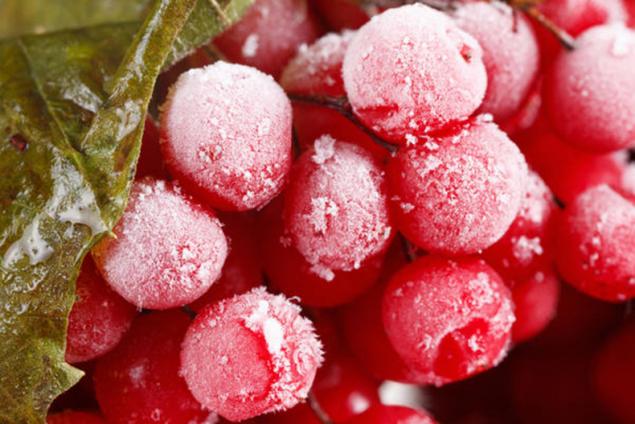
Do not lag behind and rosehip, sea buckthorn, European birch bark, squirrels (horizontal, low, Dammer, volitional and decorative), spireas and bladder. All of them will add coral and orange shades to the landscape.
The most spectacular of the red options are barberry. Just imagine a lot of small oblong fruits that, like flashlights on a garland, peek out from under the snow carpet.

A red and white set of colors will help to dilute the purple berries of a beautiful vegetable:
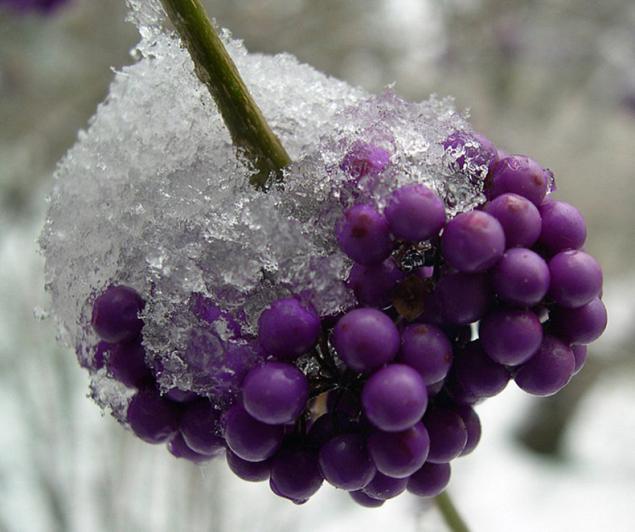
Good and dark blue fruits of arboretum black, black elderberry, irga, chernofruit and magonia padubolistic.
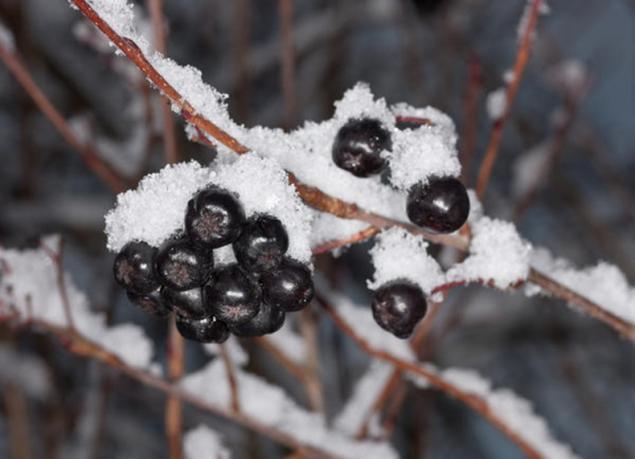
You can also play with white color. If you can not find varieties of ash with white or soft pink fruits, plant a snowberry. Some specially grow it because of the funny berries that fervently click if crushed.
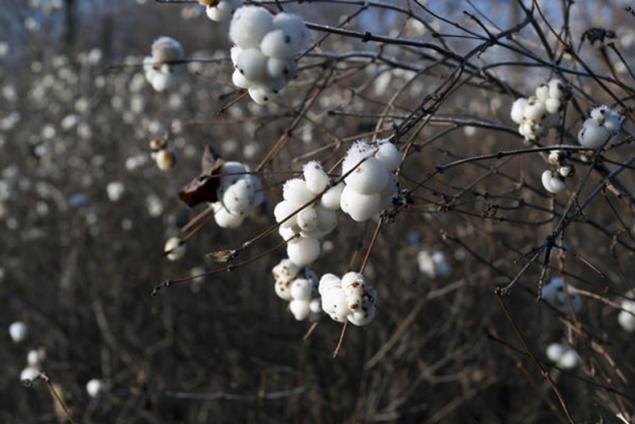
Very interesting is the round snowberry (Simphoricarpos orbiculatus) with pink fruits. You can plant several species nearby for contrast.
Connoisseurs of beauty should pay attention to the juniper of Virginia (Juniperus virginiana) with a huge number of silver-blue pine berries.
Successfully fit into the fruit and berry design of the plant with lionfish and, of course, cones. The color and shape of cones can be different, from the usual to the original. For example, the cones of Korean fir are similar to candles of the color “eggplant”, and in some larchs – to small roses of round shape.

Larch European cones at first greenish, and then turn into brown balls with curved scales, similar to petals.
Yew berry, the seeds of which are enclosed in a beautiful red pericarp, will also hold your eye. The original forms of fruits will please catalpa, glydicia and plane trees.
Emphasis on color and texture of the cortex
When creating winter landscape compositions, it is necessary to take into account the color and texture of the bark of trees and shrubs. It is not only fruits that boast original color and shape. Against the background of snow, naked shrubs with bright bark resemble the flame of a fire and cannot but cause a delighted sigh. It is for the sake of beautiful bark that various types of willow and turf, birch and beech, pines and cherries are planted.

Willow can have shoots of bright red (Cremesina variety) or golden yellow (Vitellina variety) color. Deren white is famous for smooth, shiny and very beautiful shoots of different colors. Deren white Cornus alba strikes burgundy-purple branches, Sibirica - red. By selection, varieties with black, orange or green-yellow bark are bred. Against the background of other trees, the dens will be visible from afar, especially if you choose the right "neighbors". “Neighbors” are plants for a secondary role, more calm, without color “bumps”. Deren goes well with spruces, Japanese spirea and creeping junipers. You can plant it against the background of spirea gray and fir.
Important: Do not fill the entire space with bright spots. Here, as when creating a picture, there is a great risk instead of a harmonious combination to get gaggy strokes. Use plants-separators that will smooth out the diversity. For this, shrubs with a neutral bark or coniferous plants with a monochromatic crown are ideal.
Emphasis on crown and branch shape
The shape of the branches and crowns is another aspect that can be played on when creating winter garden decor. For this, plants with any form of crown are suitable: column, pyramidal, spherical, umbrella or weeping. The leaves that give volume have long fallen, and without them geometry stands out more sharply. Trees with curved or twisted branches will look especially spectacular:


Decorative herbs
They will decorate the garden and decorative herbs. They retain their attractiveness for a long time, and in winter they are covered with frost and turn into ice "sculptures". Beauty, that's all.

Unusually, on the general background, dried oatmeal sprinkled with snow, zipper and spartin comb look. Miscanthus and cock are also good. The ears will remain green even in the first frost, until the heavy cap of snow does not bend them to the ground.

Pellovnik high (Siberian) frost resistant and overwinters perfectly. A turfed meadow with inflorescences in the form of brooms of golden color forms buds from thin root leaves. That’s why it’s called a hair piece. This plant is not so tolerant of frost, but the beginning of winter with a slight “minus” will survive.
The use of cold-resistant herbs in the design of a winter garden will create a sense of dynamics, the impression that not everything is frozen under a snow blanket. It is not only their appearance but also the sounds they make. To hear the music of the wind on your site, it is enough to plant a few tall cereals. A full “arrangement” will take a dozen or more. Cold gusty wind will rustle withered snowstorms, bend and straighten stubborn tall grasses.

It is worth choosing high enough options, preferably with thick snowstorms, but sometimes rare ears are compensated by the presence of leaves, as in a prickle.
Coniferous plants
You can easily “paint” your garden with the help of conifers alone. Fortunately, modern nurseries and shops provide ample opportunities for this.

The leaders of this “direction” are junipers of different species, fir, thui, as well as pine, spruce and yew. Especially good will look a combination of contrasting in color plants. In summer, against the background of greenery and flowering, these contrasts are not so noticeable. We choose all shades of green and blue: Echiniformis spruce - a prickly beauty with needles of a rich dark gray color with a bluish tint - and a green thuya of the Smaragd variety, an ordinary Little Gem spruce and a bright blue Koster. Very original look juniper Chinese and Western tuya.
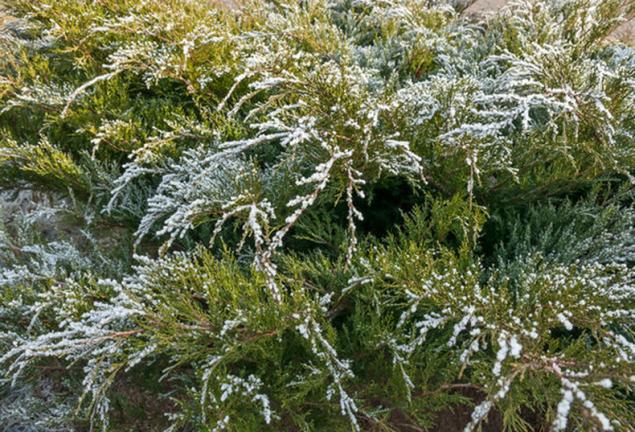
The bronze tint of crowns will please the Golden Globe tuya and the Gold Coast juniper. There are species that change color to winter. For example, juniper Andorra Compact and Winter Blue needles change color from lilac to purple. Winter Gold pine will turn from green to yellow.

You can dilute conifers with evergreen deciduous (samshite, birchbear, sourberry, magonia, barberry) and soil cover plants. Perfectly withstand and even break through the snow cover of the periwinkle leaves. They can climb to a height of 1 meter. Thyme, peels, cleaner woolly, sliver crawling form a “pillow” of greenery in winter.
Unforgettable impressions will remain from the composition of conifers, diluted with “spots” of winterers without sheltering heather and lavender, as well as iberis and freezer. And all this against the background of cold-resistant ground cover and white snow.
The Tricks of Winter Landscape Design
You can paint the garden in winter in other, “unpalatable” ways. Do you want to experiment with landscape design?
The basic principle comes down to a simple rule: divide and remove. “Remove” – because in winter it is very easy to identify all the flaws or shortcomings of the plot layout left in the summer. So everything that needs to be shown, show, and the rest out of sight. Well, "divide" refers to work on garden forms. Now we do not have a variety of colors, magnificent crowns and beauty of leaves, but the forms of the garden are exposed. It is only because of them that he can still be attractive.

A lot depends on the proper division of the territory. In order not to overdo the decoration, plan the areas filled with vegetation in advance, and think about ways to separate them from each other and from other areas. For example, with the help of colorful fences or fences.
Garden pond
If there is water on the site, then it will require close attention. The landscape will revive an ice-free decorative pond. To do this, you will need to install an automatic heater. Lovers of winter landscapes will prefer to contemplate the familiar layer of ice. In any case, next to the pond you can place sculptural elements of the winter theme, which will create a certain mood.

From other landscape trifles, use small architectural forms of unusual shapes, garden arches, interesting colored roofing material for gazebos, canopies or hozblock. If desired, you can even lay out an unobtrusive, but original ornament on the roof of the house.
Motley ribbons will wind garden paths paved with colored tiles or stone. If the site has a baby swing or a stationary sandbox, why not paint them in advance? And so dilute the background.

Important: Do not forget that the "highlight" should be several, but not the whole garden. Focus on one thing. Don’t paint everything you see. After all, in the summer, when the landscape comes to life, the site will shimmer with all the colors of the rainbow, and this does not always look organic. And constantly repainting is inconvenient and impractical.
Garden lighting
The daylight is getting shorter. In order not to look into the darkness at five in the evening and cope with the desire to go to bed, think in advance about the question of winter garden lighting. The result will give indescribable delight.

First of all, you can easily move around the garden without fear of slipping and falling. For these purposes, high lanterns located on the sides of the main paths or between the gate and the house are suitable.
Even one lantern (especially in the Japanese style) on the shore of the pond can change the garden.
Alluring lights burn small flashlights on solar batteries. They can be attached to branches or attached to the ground. In extreme cases, if you do not get to the ground, then on the top of the snowdrift.

The choice of winter lighting is large: high and miniature lanterns, stationary and solar-powered, garlands and lamps.
Garden furniture as an element of winter decoration
It will revive the site and add comfort to the garden furniture. The choice of style and material is up to you. The classic option is elegant forged furniture. From a distance, it looks like metallic lace. Openwork chair backs, intricate tables and twisted decorations on garden benches, powdered with snow, will emphasize your taste and will not go unnoticed. In addition, special care in winter forged furniture does not need.

It is very difficult to break it, so it is not afraid of snow caps. And the temperature changes, too. You can easily change the color if the old one is tired.
Important: To forged furniture served faith and truth for a long time, every 2 years you need to cover it with anti-corrosion paint.
The second most popular option is plastic furniture. For winter use, it should be chosen very carefully, giving preference to high-quality plastic (so that it can withstand frosts), unobtrusive models and non-toxic colors. Plastic furniture will serve much less forged. But with good care, it can withstand both heat and frost for several seasons, maintaining a “commodity” appearance.
The use of wooden furniture in winter is in question. The aesthetic component, variety of shades and universality do not cause doubts.

But the dependence on weather conditions and fire hazard is a little embarrassing. Of course, if you wish, you can buy a budget version of wooden furniture so that it is not too pity to throw it away later if it deforms or loses its appearance. Then cover the purchase with a special protective composition (you can varnish or paint) and see how it behaves in the winter. In winter, it is better to replace wooden furniture with alternatives.
Similarly, wicker furniture from natural materials behaves. To the cold, she is even more sensitive. Therefore, it must be protected from moisture and cold. But what if you really want to decorate your garden with such a light, elegant thing? New wicker furniture, suppose, of rattan, will not survive the winter - this is a fact.
But if in your shed there is an old unnecessary wicker chair or even a whole set that the hand does not rise to throw away, feel free to use it. Repaint in a more saturated color (for example, in burgundy or brown). Since the furniture is light, consider how to fix it in case of strong winds. Naturally, it will not be able to function at full capacity, but it will serve as a design element. And in case of damage, throwing it away will not be so pathetic.
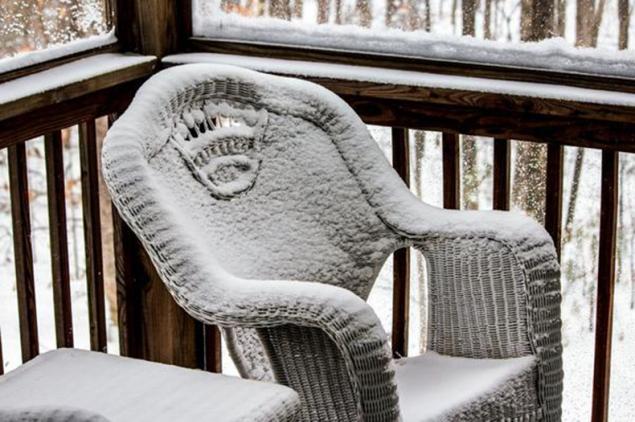
Artificial rattan furniture can compete with plastic. It's unpretentious and functional. It feels great both in winter and in summer. It is not always published and not everyone can distinguish it from natural. At the same time, artificial garden furniture will properly serve even in the cold.
Sculptural elements
And finally, the most interesting, purely winter decoration of the garden is sculptures. What are they, if not snow and ice? Nothing will give adults and children such pleasure as sculpting snowmen or ice toys, which will become a unique element of the design of your site. The simplest thing is to create colored ice balls.

How to make colored ice balls?
Step 1: Preparing materials
For the production of colored ice balls we will need:
It is better to do this in accordance with the proportions indicated in the instructions, so that the color is saturated.
Step 3: Fill the balls with colored water.
Don't forget to stop!
Step 4: We leave balls in the cold.
As a rule, with frost from -3 °C to -5 °C, it is enough day for our composition to freeze.
Step 5: Remove the shell
When the water freezes, carefully remove the film. Done!
Everything is very simple, and the result is beautiful, like glass jewelry. They can be "scattered" in the garden, in prominent places. It can be placed on tree branches. A huge plus will be the presence of a lantern, whose light, falling through the branches on the ball, will make it bizarrely twinkle and shimmer.
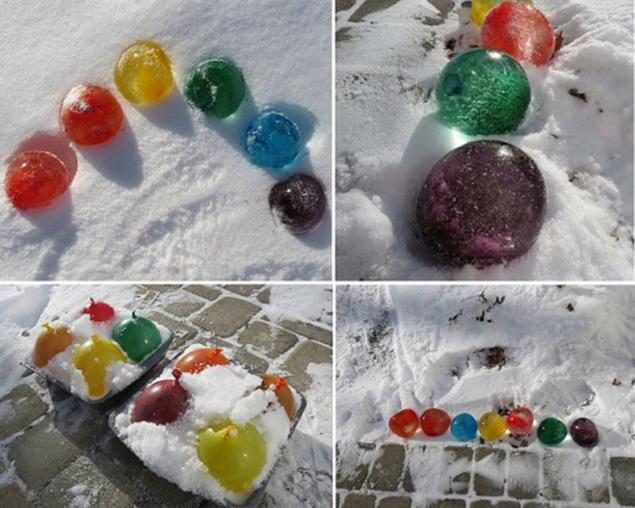
A low Christmas tree can turn into a winter sculpture, carried by snow. Just attach expressive eyes and bright lips made of cardboard to it. It will turn out very similar to a funny girl in a headscarf (in his role will snow, just clean it from the branches in shape).
There's no escape from the snowmen. They can be the most common, with a carrot instead of a nose and a bucket on the head.
They can be very original. In the form of animals or cartoon characters. Is there an old carnival costume in the attic? Put a snowman in him and he will become an interesting character.
Snowmen-policemen, firefighters, hockey players will come to life. Snowman-acrobat, making a stand on his head, will give a sea of joy to children. The snowman looks funny - a parody of the owner of the site. We put our belongings on it and add any accessory with which you can be associated. For example, for a man it is a favorite pipe or cane, for a woman – a hat or a handbag. What about a snowman gardener with a straw hat, rubber gloves and rakes? Or a severe snow woman in curlers and with a roller coaster, meeting her husband at the gate?!

Interesting: Now in stores you can even buy a special frame for sculpting a snowman. It will strengthen the design and facilitate the work of the “sculptors”.

Don’t forget about ordinary dolls. Many of them fall apart and live out their lives in the dacha. Give them a second life in the form of street decoration. Take a wicker box with a lid (you can the so-called basket for dirty laundry), attach boots or boots to it. It turns out that the box is standing on legs. Then, from above in the center of the box, attach the head from the doll, attach the hands. These can be cut off sleeves stuffed with any material. And then we make an image of her. We put on a hat, scarf, so that you can not see the place of fastening of parts, mittens. Nearby you can put a shovel, an old samovar, buckets with a bucket... whatever.
You can put another beautiful girl on the bench. The principle of its manufacture is the same: we take a wicker box, we attach our head and hands to it. We don’t need to make our feet because our snow lady will be sitting. From above, throw an old coat, put on a hat, a shawl and mittens. Done! If the fantasy played out and just the dolls are not enough, hang next to the dummy onions or pumpkins - you will get a vegetable seller, put rakes and a bucket next to you - a tired gardener.
Here are such cunning and not very ways you can revitalize your garden during snowstorms and cold weather. Unlike nature, you and I are not going to sleep. published
Author of the article Ekaterina Frolova
P.S. And remember, just changing our consumption – together we change the world!
Join us on Facebook, VKontakte, Odnoklassniki
Source: www.7dach.ru/FrolovaEkaterina/kak-dobavit-krasok-zimnemu-sadu-45390.html
One fine morning you look out the window and see that the garden is covered with white carpet. It was as if he had lost his colors and fell asleep waiting for spring. How to break the stereotype that the garden in winter is a snow cover with dull peeping naked trees? How to make it a variety and bright accents?

Where to start?
The most “timely” answer to the question “Where to start?” will be the famous saying about the sled in summer and the cart in winter. In the role of a sled, we have the preparation of a plot plan and marking up on it all the “winter” details that need to be taken into account. For example, where it is better to plant evergreen plants and which ones. But more on that later.
In the meantime, we arm ourselves with paper, pencil, irrepressible imagination of the gardener and the necessary knowledge and sketch a plan. It is best to do this in early spring, in March-April. At this time, the garden is quite naked, and you can see in detail how it looks as a whole. In the eyes immediately throw areas with uneven landscape.
You will see where there are too many shrubs or trees, and where, on the contrary, empty. Will not go unnoticed and "mistakes of economic purpose": compost box, old barrels, covering material or forgotten from the autumn inventory. In summer, during the period of active flowering, such nuances are not visible. And here it is immediately clear what is most naked in winter and how best to hide it.

If everything is cleaned up or does not confuse you and fits perfectly into the overall picture, you can just experiment and bring brightness to the winter landscape. It's done in different ways. The first thing that comes to mind is the decoration of the garden with the help of trees, shrubs and other plants. Let's call it plant-based.
Plant decoration for the winter garden
This option is ideal for lovers of naturalness, since there is no excessive gaggyness and heaping of elements alien to nature. To preserve the “vegetable” brightness and originality of the garden in winter, it is enough to choose in advance and plant the right specimens.

It is difficult to immediately navigate the variety of plants suitable for our venture. It is better to divide them into groups, each of which is responsible for a certain “highlight”. It's important not to overdo it. Still, in the winter garden there should be enough space for cold winds, swinging tree branches and howling in the stove pipe, and for snowdrifts.
Fruit and berry decoration
This group of “decorations” include trees and shrubs with bright berries and bizarre cones. Colorful fruits are not only pleasing to the eye: some of them are edible and very useful, and not only for people, but also for birds that will become frequent guests in your garden.
Let’s remember the beloved since childhood, ordinary ash. It is always visible from afar thanks to the berries of juicy color, which remain on the branches all winter.

Fans of exotic can plant other varieties of ash, whose "beads" will surprise with a variety of colors, from alabastro-white to fiery orange.
Arnold’s hybrid ash has several varieties that are perfect for winter decor. The variety Carpet of gold is distinguished by golden yellow fruits, Kirsten Pink - pink, Red Tip - delicate white and pink. White "lanterns" will be allocated and berries of the White Wax variety. Spectacular look varieties Schouten and Chamois Glow with orange-red, closer to brown, berries.
Do not pass by the mountain ash (Sorbus thuringiaca), the beautiful mountain ash (Sorbus cashmiriana), the exotic mountain ash (Sorbus hupehensis) and the bush ash Kene (Sorbus koehneana).

Almost all winter through the snow berries on the branches of hawthorn: plum, blood-red and one-pestilent.
Kalina red... where without her bunches in the winter garden? It has long been a traditional winter decoration.

Do not lag behind and rosehip, sea buckthorn, European birch bark, squirrels (horizontal, low, Dammer, volitional and decorative), spireas and bladder. All of them will add coral and orange shades to the landscape.
The most spectacular of the red options are barberry. Just imagine a lot of small oblong fruits that, like flashlights on a garland, peek out from under the snow carpet.

A red and white set of colors will help to dilute the purple berries of a beautiful vegetable:

Good and dark blue fruits of arboretum black, black elderberry, irga, chernofruit and magonia padubolistic.

You can also play with white color. If you can not find varieties of ash with white or soft pink fruits, plant a snowberry. Some specially grow it because of the funny berries that fervently click if crushed.

Very interesting is the round snowberry (Simphoricarpos orbiculatus) with pink fruits. You can plant several species nearby for contrast.
Connoisseurs of beauty should pay attention to the juniper of Virginia (Juniperus virginiana) with a huge number of silver-blue pine berries.
Successfully fit into the fruit and berry design of the plant with lionfish and, of course, cones. The color and shape of cones can be different, from the usual to the original. For example, the cones of Korean fir are similar to candles of the color “eggplant”, and in some larchs – to small roses of round shape.

Larch European cones at first greenish, and then turn into brown balls with curved scales, similar to petals.
Yew berry, the seeds of which are enclosed in a beautiful red pericarp, will also hold your eye. The original forms of fruits will please catalpa, glydicia and plane trees.
Emphasis on color and texture of the cortex
When creating winter landscape compositions, it is necessary to take into account the color and texture of the bark of trees and shrubs. It is not only fruits that boast original color and shape. Against the background of snow, naked shrubs with bright bark resemble the flame of a fire and cannot but cause a delighted sigh. It is for the sake of beautiful bark that various types of willow and turf, birch and beech, pines and cherries are planted.

Willow can have shoots of bright red (Cremesina variety) or golden yellow (Vitellina variety) color. Deren white is famous for smooth, shiny and very beautiful shoots of different colors. Deren white Cornus alba strikes burgundy-purple branches, Sibirica - red. By selection, varieties with black, orange or green-yellow bark are bred. Against the background of other trees, the dens will be visible from afar, especially if you choose the right "neighbors". “Neighbors” are plants for a secondary role, more calm, without color “bumps”. Deren goes well with spruces, Japanese spirea and creeping junipers. You can plant it against the background of spirea gray and fir.
Important: Do not fill the entire space with bright spots. Here, as when creating a picture, there is a great risk instead of a harmonious combination to get gaggy strokes. Use plants-separators that will smooth out the diversity. For this, shrubs with a neutral bark or coniferous plants with a monochromatic crown are ideal.
Emphasis on crown and branch shape
The shape of the branches and crowns is another aspect that can be played on when creating winter garden decor. For this, plants with any form of crown are suitable: column, pyramidal, spherical, umbrella or weeping. The leaves that give volume have long fallen, and without them geometry stands out more sharply. Trees with curved or twisted branches will look especially spectacular:

- Haze ordinary office (Contorta Corylus avelanna): shoots twisted like a corkscrew. At the very beginning of winter, earrings will appear on it, which will add charm to the already original bush.
- The willow of Matsudan and the willow of Babylon are small, but very interesting trees with “crooked” branches. You can plant them anywhere, care requires minimal, but the pleasure of contemplation will bring a lot.
- "The nail of the program" - Japanese willow (iva whole-leaf Hakuro-Nishiki). The tree is 3-5 meters high with a beautiful spherical crown. Flat, winding branches of yellow-green or green-red color will not leave indifferent any connoisseur.

Decorative herbs
They will decorate the garden and decorative herbs. They retain their attractiveness for a long time, and in winter they are covered with frost and turn into ice "sculptures". Beauty, that's all.

Unusually, on the general background, dried oatmeal sprinkled with snow, zipper and spartin comb look. Miscanthus and cock are also good. The ears will remain green even in the first frost, until the heavy cap of snow does not bend them to the ground.

Pellovnik high (Siberian) frost resistant and overwinters perfectly. A turfed meadow with inflorescences in the form of brooms of golden color forms buds from thin root leaves. That’s why it’s called a hair piece. This plant is not so tolerant of frost, but the beginning of winter with a slight “minus” will survive.
The use of cold-resistant herbs in the design of a winter garden will create a sense of dynamics, the impression that not everything is frozen under a snow blanket. It is not only their appearance but also the sounds they make. To hear the music of the wind on your site, it is enough to plant a few tall cereals. A full “arrangement” will take a dozen or more. Cold gusty wind will rustle withered snowstorms, bend and straighten stubborn tall grasses.

It is worth choosing high enough options, preferably with thick snowstorms, but sometimes rare ears are compensated by the presence of leaves, as in a prickle.
Coniferous plants
You can easily “paint” your garden with the help of conifers alone. Fortunately, modern nurseries and shops provide ample opportunities for this.

The leaders of this “direction” are junipers of different species, fir, thui, as well as pine, spruce and yew. Especially good will look a combination of contrasting in color plants. In summer, against the background of greenery and flowering, these contrasts are not so noticeable. We choose all shades of green and blue: Echiniformis spruce - a prickly beauty with needles of a rich dark gray color with a bluish tint - and a green thuya of the Smaragd variety, an ordinary Little Gem spruce and a bright blue Koster. Very original look juniper Chinese and Western tuya.

The bronze tint of crowns will please the Golden Globe tuya and the Gold Coast juniper. There are species that change color to winter. For example, juniper Andorra Compact and Winter Blue needles change color from lilac to purple. Winter Gold pine will turn from green to yellow.

You can dilute conifers with evergreen deciduous (samshite, birchbear, sourberry, magonia, barberry) and soil cover plants. Perfectly withstand and even break through the snow cover of the periwinkle leaves. They can climb to a height of 1 meter. Thyme, peels, cleaner woolly, sliver crawling form a “pillow” of greenery in winter.
Unforgettable impressions will remain from the composition of conifers, diluted with “spots” of winterers without sheltering heather and lavender, as well as iberis and freezer. And all this against the background of cold-resistant ground cover and white snow.
The Tricks of Winter Landscape Design
You can paint the garden in winter in other, “unpalatable” ways. Do you want to experiment with landscape design?
The basic principle comes down to a simple rule: divide and remove. “Remove” – because in winter it is very easy to identify all the flaws or shortcomings of the plot layout left in the summer. So everything that needs to be shown, show, and the rest out of sight. Well, "divide" refers to work on garden forms. Now we do not have a variety of colors, magnificent crowns and beauty of leaves, but the forms of the garden are exposed. It is only because of them that he can still be attractive.

A lot depends on the proper division of the territory. In order not to overdo the decoration, plan the areas filled with vegetation in advance, and think about ways to separate them from each other and from other areas. For example, with the help of colorful fences or fences.
Garden pond
If there is water on the site, then it will require close attention. The landscape will revive an ice-free decorative pond. To do this, you will need to install an automatic heater. Lovers of winter landscapes will prefer to contemplate the familiar layer of ice. In any case, next to the pond you can place sculptural elements of the winter theme, which will create a certain mood.

From other landscape trifles, use small architectural forms of unusual shapes, garden arches, interesting colored roofing material for gazebos, canopies or hozblock. If desired, you can even lay out an unobtrusive, but original ornament on the roof of the house.
Motley ribbons will wind garden paths paved with colored tiles or stone. If the site has a baby swing or a stationary sandbox, why not paint them in advance? And so dilute the background.

Important: Do not forget that the "highlight" should be several, but not the whole garden. Focus on one thing. Don’t paint everything you see. After all, in the summer, when the landscape comes to life, the site will shimmer with all the colors of the rainbow, and this does not always look organic. And constantly repainting is inconvenient and impractical.
Garden lighting
The daylight is getting shorter. In order not to look into the darkness at five in the evening and cope with the desire to go to bed, think in advance about the question of winter garden lighting. The result will give indescribable delight.

First of all, you can easily move around the garden without fear of slipping and falling. For these purposes, high lanterns located on the sides of the main paths or between the gate and the house are suitable.
Even one lantern (especially in the Japanese style) on the shore of the pond can change the garden.
Alluring lights burn small flashlights on solar batteries. They can be attached to branches or attached to the ground. In extreme cases, if you do not get to the ground, then on the top of the snowdrift.

The choice of winter lighting is large: high and miniature lanterns, stationary and solar-powered, garlands and lamps.
Garden furniture as an element of winter decoration
It will revive the site and add comfort to the garden furniture. The choice of style and material is up to you. The classic option is elegant forged furniture. From a distance, it looks like metallic lace. Openwork chair backs, intricate tables and twisted decorations on garden benches, powdered with snow, will emphasize your taste and will not go unnoticed. In addition, special care in winter forged furniture does not need.

It is very difficult to break it, so it is not afraid of snow caps. And the temperature changes, too. You can easily change the color if the old one is tired.
Important: To forged furniture served faith and truth for a long time, every 2 years you need to cover it with anti-corrosion paint.
The second most popular option is plastic furniture. For winter use, it should be chosen very carefully, giving preference to high-quality plastic (so that it can withstand frosts), unobtrusive models and non-toxic colors. Plastic furniture will serve much less forged. But with good care, it can withstand both heat and frost for several seasons, maintaining a “commodity” appearance.
The use of wooden furniture in winter is in question. The aesthetic component, variety of shades and universality do not cause doubts.

But the dependence on weather conditions and fire hazard is a little embarrassing. Of course, if you wish, you can buy a budget version of wooden furniture so that it is not too pity to throw it away later if it deforms or loses its appearance. Then cover the purchase with a special protective composition (you can varnish or paint) and see how it behaves in the winter. In winter, it is better to replace wooden furniture with alternatives.
Similarly, wicker furniture from natural materials behaves. To the cold, she is even more sensitive. Therefore, it must be protected from moisture and cold. But what if you really want to decorate your garden with such a light, elegant thing? New wicker furniture, suppose, of rattan, will not survive the winter - this is a fact.
But if in your shed there is an old unnecessary wicker chair or even a whole set that the hand does not rise to throw away, feel free to use it. Repaint in a more saturated color (for example, in burgundy or brown). Since the furniture is light, consider how to fix it in case of strong winds. Naturally, it will not be able to function at full capacity, but it will serve as a design element. And in case of damage, throwing it away will not be so pathetic.

Artificial rattan furniture can compete with plastic. It's unpretentious and functional. It feels great both in winter and in summer. It is not always published and not everyone can distinguish it from natural. At the same time, artificial garden furniture will properly serve even in the cold.
Sculptural elements
And finally, the most interesting, purely winter decoration of the garden is sculptures. What are they, if not snow and ice? Nothing will give adults and children such pleasure as sculpting snowmen or ice toys, which will become a unique element of the design of your site. The simplest thing is to create colored ice balls.

How to make colored ice balls?
Step 1: Preparing materials
For the production of colored ice balls we will need:
- balloons of different shapes and sizes,
- You will be able to enjoy the best food if you have a child with you.
- water
- Creativity and a strong frost outside the window.
It is better to do this in accordance with the proportions indicated in the instructions, so that the color is saturated.
Step 3: Fill the balls with colored water.
Don't forget to stop!
Step 4: We leave balls in the cold.
As a rule, with frost from -3 °C to -5 °C, it is enough day for our composition to freeze.
Step 5: Remove the shell
When the water freezes, carefully remove the film. Done!
Everything is very simple, and the result is beautiful, like glass jewelry. They can be "scattered" in the garden, in prominent places. It can be placed on tree branches. A huge plus will be the presence of a lantern, whose light, falling through the branches on the ball, will make it bizarrely twinkle and shimmer.

A low Christmas tree can turn into a winter sculpture, carried by snow. Just attach expressive eyes and bright lips made of cardboard to it. It will turn out very similar to a funny girl in a headscarf (in his role will snow, just clean it from the branches in shape).
There's no escape from the snowmen. They can be the most common, with a carrot instead of a nose and a bucket on the head.
They can be very original. In the form of animals or cartoon characters. Is there an old carnival costume in the attic? Put a snowman in him and he will become an interesting character.
Snowmen-policemen, firefighters, hockey players will come to life. Snowman-acrobat, making a stand on his head, will give a sea of joy to children. The snowman looks funny - a parody of the owner of the site. We put our belongings on it and add any accessory with which you can be associated. For example, for a man it is a favorite pipe or cane, for a woman – a hat or a handbag. What about a snowman gardener with a straw hat, rubber gloves and rakes? Or a severe snow woman in curlers and with a roller coaster, meeting her husband at the gate?!

Interesting: Now in stores you can even buy a special frame for sculpting a snowman. It will strengthen the design and facilitate the work of the “sculptors”.

Don’t forget about ordinary dolls. Many of them fall apart and live out their lives in the dacha. Give them a second life in the form of street decoration. Take a wicker box with a lid (you can the so-called basket for dirty laundry), attach boots or boots to it. It turns out that the box is standing on legs. Then, from above in the center of the box, attach the head from the doll, attach the hands. These can be cut off sleeves stuffed with any material. And then we make an image of her. We put on a hat, scarf, so that you can not see the place of fastening of parts, mittens. Nearby you can put a shovel, an old samovar, buckets with a bucket... whatever.
You can put another beautiful girl on the bench. The principle of its manufacture is the same: we take a wicker box, we attach our head and hands to it. We don’t need to make our feet because our snow lady will be sitting. From above, throw an old coat, put on a hat, a shawl and mittens. Done! If the fantasy played out and just the dolls are not enough, hang next to the dummy onions or pumpkins - you will get a vegetable seller, put rakes and a bucket next to you - a tired gardener.
Here are such cunning and not very ways you can revitalize your garden during snowstorms and cold weather. Unlike nature, you and I are not going to sleep. published
Author of the article Ekaterina Frolova
P.S. And remember, just changing our consumption – together we change the world!
Join us on Facebook, VKontakte, Odnoklassniki
Source: www.7dach.ru/FrolovaEkaterina/kak-dobavit-krasok-zimnemu-sadu-45390.html






